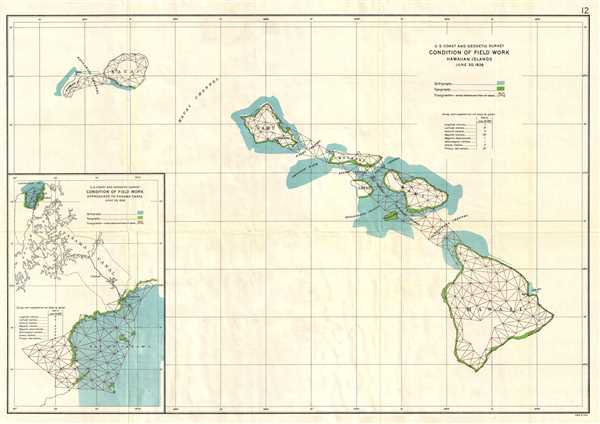This item has been sold, but you can get on the Waitlist to be notified if another example becomes available, or purchase a digital scan.
1926 U.S. Coast and Geodetic Survey Map of Field Work in Hawaii
ConditionHawaii-uscgs-1926
Title
1926 (dated) 15.5 x 22 in (39.37 x 55.88 cm) 1 : 1200000
Description
Created for the Annual Report of the Director, United States Coast and Geodetic Survey of 1926, the 'condition' of field work accomplished by the agency is illustrated, using different forms of notation. 'Condition' means the total amount of field work accomplished to date. Hydrography surveys are depicted in light blue and have been completed around all the islands in the region, with some islands, particularly Oahu, and Maui, garnering more attention than others. Topographic surveys, which cover nearly the entirety of all the islands (some of the center of Hawaii has not been surveyed) are illustrated in green. Triangulation surveys are depicted by the red interconnected triangles and have been employed extensively throughout the region, both on the islands and in the channels separating them. A key explaining the different notations utilized on the map is located on the upper right, and a table just below the key lists other forms of survey work completed in the region. The table states that, in the Hawaiian Islands, the only type of station which has not been established is an azimuth station.
An inset map, detailing the condition of field work around the approaches to the Panama Canal is situated in the lower left corner. The information presented here illustrates that extensive hydrographic surveys had been conducted in the Bay of Panama and in Limon Bay. Topographic surveys had been completed along both coastlines, and both the Bay of Panama and Limon Bay had been extensively mapped using triangulation surveys. A table listing the other types of surveys completed in the region is located on the lower left.
This map was produced by the U.S. Coast and Geodetic Survey for inclusion in the Annual Report of the Director of the Coast and Geodetic Survey. The director in 1926 was E. Lester Jones.
Cartographer
The Office of the Coast Survey (later the U.S. Geodetic Survey) (1807 - present), founded in 1807 by President Thomas Jefferson and Secretary of Commerce Albert Gallatin, is the oldest scientific organization in the U.S. Federal Government. Jefferson created the "Survey of the Coast," as it was then called, in response to a need for accurate navigational charts of the new nation's coasts and harbors. The first superintendent of the Coast Survey was Swiss immigrant and West Point mathematics professor Ferdinand Hassler. Under the direction of Hassler, from 1816 to 1843, the ideological and scientific foundations for the Coast Survey were established. Hassler, and the Coast Survey under him developed a reputation for uncompromising dedication to the principles of accuracy and excellence. Hassler lead the Coast Survey until his death in 1843, at which time Alexander Dallas Bache, a great-grandson of Benjamin Franklin, took the helm. Under the leadership A. D. Bache, the Coast Survey did most of its most important work. During his Superintendence, from 1843 to 1865, Bache was steadfast advocate of American science and navigation and in fact founded the American Academy of Sciences. Bache was succeeded by Benjamin Pierce who ran the Survey from 1867 to 1874. Pierce was in turn succeeded by Carlile Pollock Patterson who was Superintendent from 1874 to 1881. In 1878, under Patterson's superintendence, the U.S. Coast Survey was reorganized as the U.S. Coast and Geodetic Survey (C & GS or USGS) to accommodate topographic as well as nautical surveys. Today the Coast Survey is part of the National Oceanic and Atmospheric Administration or NOAA. More by this mapmaker...

